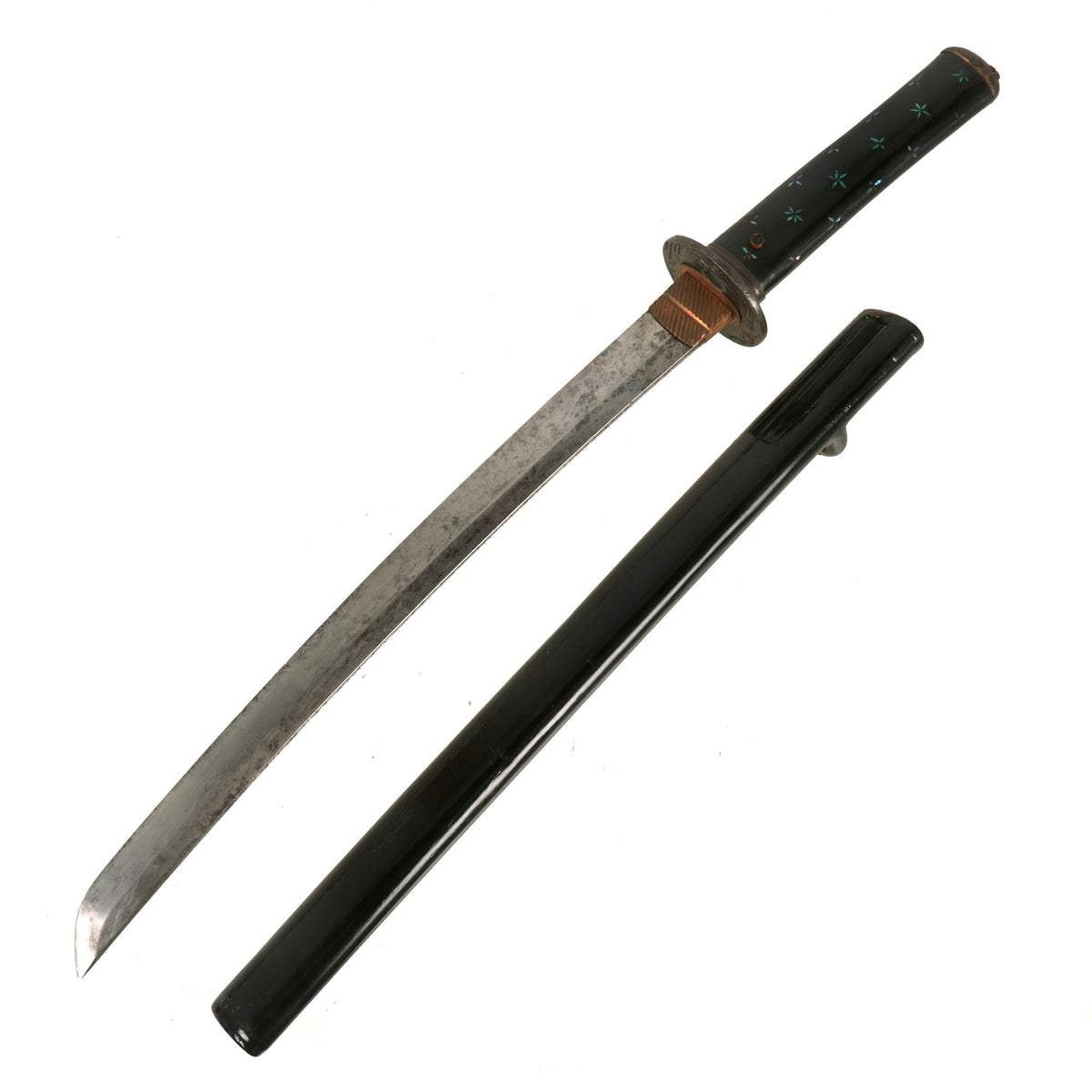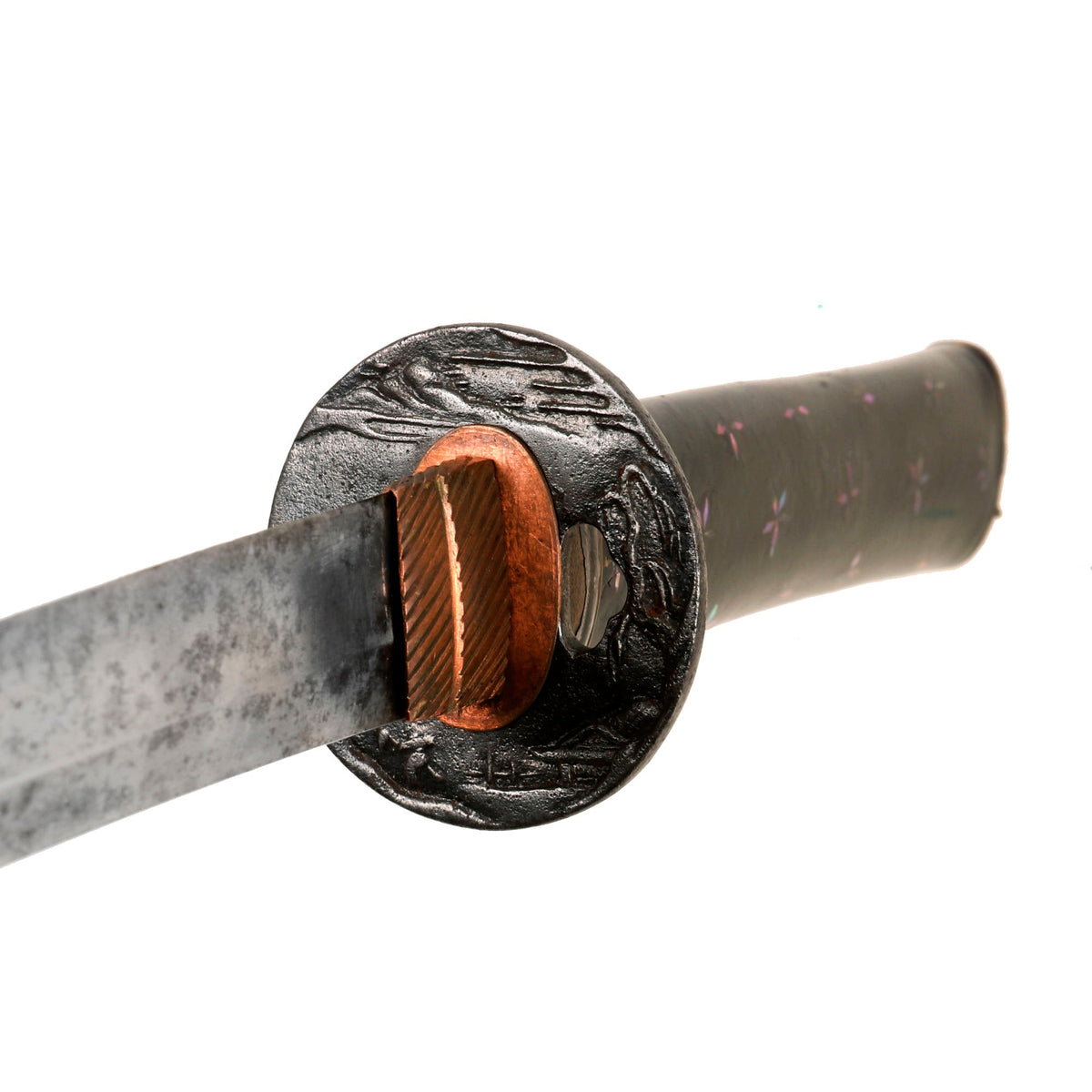Original 18th Century Edo Period Japanese Handmade Wakizashi Short Sword with Abalone Shell Inlaid Handle and Scabbard Original Items
$ 995,00 $ 248,75
Original Item: Only One Available. Wakizashi (脇差 “side inserted / companion sword”) is a general term for a sword with an edge between one and two shaku long (30 cm and 60 cm), predominantly made after 1600. Generally it is the short blade that accompanies a katana in the traditional samurai daisho pairing of swords, but may be worn by classes other than the samurai as a single blade, also worn edge up as the katana.
This very nice example dates from the Edo period (江戸時代, Edo jidai) or Tokugawa period (徳川時代, Tokugawa jidai) of Japanese history. This is the period between 1603 and 1867, when Japan was under the rule of the Tokugawa shogunate and the country’s 300 regional daimyo.
This example has been remounted several times, as was common for Japanese blades. This has made the file marks (yasurimi) on the tang faint, and given it a lovely patina. There is a bit of oxidation, but no major scaling, so it looks like it was probably made during the later Edo period, circa 1800. There is no signature on the blade, so it is considered 無銘 (mumei), or “anonymous”. There are many smiths who did not sign all of their blades, and the lack of a signature is no indicator of original quality.
The blade has the following period correct features:
– Folded steel blade (fold lines are evident on the spine and body of the blade)
– Hole (mekugi-ana) in the tang is punched and not drilled.
– Tang of the Katana shows significant age.
– Very faintly visible temper line (hamon) near the edge of the blade.
– Blade wounds (kizu) or lamination artifacts are present on the blade. Both ware (lamination lines) and fukure (carbon pits) are visible, only possible on traditionally made blades.
Offered in very nice condition, the blade definitely shows signs of use, oxidation, and subsequent field cleaning since the last time it was polished. There are some nicks on the edge of the blade, and some past oxidation visible as well. The polish is definitely degraded, which makes it hard to see the aspects of the blade such as the hamon temper line.
The blade length is approximately 15 inches and overall length 23 inches. This classifies the sword as a long wakizashi (Japanese: 脇差, “side inserted [sword]”), which is a shorter version of the Katana, with a blade length between 12 and 24 in. Katanas must be longer than 2 shaku (Japanese: 尺), which is approximately 12 inches in length. The blade is the “Shinogi-Zukuri” shape, the same as the longer katana, which is a shape with a “Shinogi”, or blade ridge. The sword has a traditionally handmade blade with a Futsu 普通 (regular) Nakago (tang) and a Haagari (asymmetrical rounded) nakago-jiri (tang tip).
Due to the polish condition, we can only see part of the temper line (刃文- HAMON), which looks to be of the MIDARE (乱れ – irregular) shape. There are also KIZU (blade wounds), which include WARE lamination lines and FUKURE carbon pits. There are no fatal flaws such as cracks and other issues. The yokote and boshi on the kissaki are unfortunately not visible.
The tsuba (cross guard) is made of nicely patinated iron MARU GATA (Round) shaped piece, and it has hitsu-ana holes for both kogai and kozuka, so that their handles can fit through when the sword is sheathed. It is embossed / cast with landscape scenes on both sides, which are quite nice. There are two copper seppa around the crossguard, and the fuchi (collar) is made from copper, which looks to have plating peeling off. It has a copper habaki blade collar typical of the Edo period, which shows a nice pattern.
The TSUKA (handle) on this wakizashi is really something else, coated with black urushi lacquer that has inlaid star or flower decorations, made from multiple small pieces of abalone shell. The finish is still in great shape, and the kashira (end cap) looks to be made from copper or brass, and has an embossed beetle on the bottom. The handle is held in place by a replacement peg, and the handle is a bit loose on the tang.
The sword comes in a a well fitting wooden scabbard (saya), which has a very nice gloss black urushi lacquer finish. This looks like it may have been touched up during the early 20th century, but the correct material was used. There are not any major cracks along the seams. The scabbard has a kurikata (knob), which is where a sageo sword cord might be kept, and there is a brass shitodome fitting inside the channel. It also has as slot on the other side for a kogatana knife, but there is not one included.
A very nice Edo Period Wakizashi complete with some lovely aged fittings and a beautiful decorative tsuba handle. Ready to research and display!
Specifications:
Blade Length: 15″
Blade Shape: Shinogi-Zukuri (鎬造)
Overall length: 23“
Scabbard Length: 16 ½”
It has been over one thousand years ago that the art of making swords appeared in Japan. The swordsmiths of the time may not have known it but they were creating a legendary sword. The Samurai sword has seen combat in many battlefields. From the early days of the Samurai warrior to the fierce battles in the South Pacific during WWII.
Each hand-made Japanese blade (日本刀 – Nihonto) is unique because it is forged from multiple pieces of folded steel stock. A tremendous amount of work is dedicated to creating these pieces. They were an instrument of war as much as a beautiful artifact to adorn a room.
The traditional Japanese blade and mountings have grown to be one of the most highly desired military antiques.
Fast Shipping with Professional Packaging
Thanks to our longstanding association with UPS FedEx DHL, and other major international carriers, we are able to provide a range of shipping options. Our warehouse staff is expertly trained and will wrap your products according to our exact and precise specifications. Prior to shipping, your goods will be thoroughly examined and securely secured. We ship to thousands clients each day across multiple countries. This shows how we're dedicated to be the largest retailer on the internet. Warehouses and distribution centres can be located throughout Europe as well as the USA.
Note: Orders with more than one item will be assigned a processing date depending on the item.
Before shipping before shipping, we'll conduct a thorough inspection of the items you have ordered. Today, the majority of orders will be delivered within 48 hours. The delivery time will be between 3-7 days.
Returns
The stock is dynamic and we cannot completely manage it because multiple stakeholders are involved, including our factory and warehouse. So the actual stock may alter at any time. It's possible that you may not receive your order once the order has been made.
Our policy is valid for a period of 30 days. If you don't receive the product within 30 days, we are not able to issue a refund or an exchange.
You can only return an item if it is unused and in the same state as the day you received it. You must have the item in its original packaging.
Related products
Uncategorized
Uncategorized
Uncategorized
Armoured Fighting Vehicles of the World: AFVs of World War One (Hardcover Book) New Made Items
Uncategorized
Uncategorized
Uncategorized
Uncategorized
Uncategorized
Australian WWII Owen MK1 Machine Carbine SMG Custom Fabricated Replica with Sling Original Items
Uncategorized
Uncategorized
Uncategorized
Uncategorized
Armored Burgonet Helmet & Polearm from Scottish Castle Leith Hall Circa 1700 Original Items
Uncategorized
Uncategorized
Uncategorized
Uncategorized
Uncategorized












































































